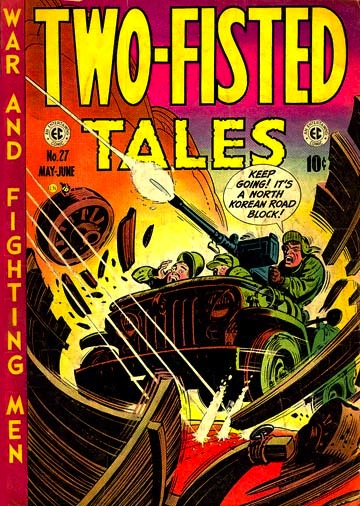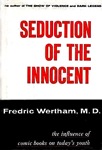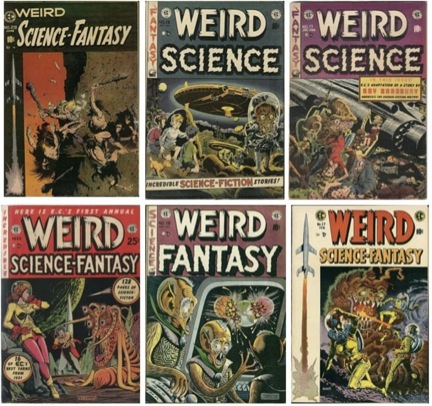Mad, Bad, and Dangerous to Know
Toward the end of M.C. Gaines’ time at EC Comics, he had rebranded the humor comics with an “Entertaining Comics” logo. When Bill Gaines took over the company upon his father’s demise, he continued to advertise “Educational Comics” in the back of his publications, but publishing “Entertaining Comics” was his focus.
Bill Gaines had every intention of applying his new chemistry degree to a life of teaching until his father’s death forced him to reconsider. Thrust into a new role in which he had no experience and no real interest, the younger Gaines nevertheless did have an eye for talent, along with a willingness to let that talent create without restriction.
Within three years’ time, the resulting comics Gaines published had transformed EC Comics into a powerhouse, one of the most successful comics publishers in history. Gone were stories based simply on the Bible and history. Instead, Gaines began publishing a wide array of horror, science fiction and war series. These comics were notable for advancing the medium in multiple ways:
- They put a premium on both writing and art. Gaines and his editors, Al Feldstein and Harvey Kurtzman, developed comics that attracted some of the biggest names in the 1950s comic-book world, including Johnny Craig, Jack Davis, Frank Frazetta, Joe Kubert, Joe Orlando, John Severin and his sister Marie Severin, Al Williamson, Wally Wood and many others. Feldstein himself was an acclaimed artist who also wrote for and edited nearly every EC publication.
- They promoted the comic-book artist as much as the comic itself. In the 1950s, with very few exceptions, creator names were not added to comic books. EC Comics changed that, having their talented writers sign their name to their works and hyping the artists to the public. In today’s world of superstar artists, this doesn’t seem unique, but at the time, it caused a sea change in comic-book credits. EC Comics talked directly to the readers through editorial pages, forming relationships and fostering loyalty among their fanbase, and they used this outlet to make stars out of their stable of talent.
- They expanded the marketplace. Comic books had largely been seen as children’s publications, with pre-teen readers numbering into the millions. Adult readers were rare, but EC’s more adult-oriented fare, their horror, crime, science fiction and war comics, brought in an older reader base while still entertaining younger readers with solid stories and beautiful art.

TWO-FISTED TALES, with its emphasis on war comics, was the brainchild of editor/writer Harvey Kurtzman.
However, as much as this last point was a boon to the industry, it also sowed the seeds for the company’s downfall. EC Comics under Bill Gaines had gained prominence by publishing titles like WEIRD SCIENCE, TALES FROM THE CRYPT, SHOCK SUSPENSTORIES, CRIME SUSPENSTORIES, TWO-FISTED TALES and THE VAULT OF HORROR. But these comics weren’t just gratuitously titled stories designed to shock and titillate. Rather, the war comics pioneered by Kurtzman looked at the futility of war; the horror comics’ darkly humorous tales featured bad characters getting their comeuppance, often in shocking “twist” endings; and the science fiction comics held a mirror up to society with their explorations of weighty themes like racism and imperialism. They were truly innovative publications enabled by the creatively free and encouraging platform that Gaines provided.

This infamous cover would come back to haunt Gaines when he was forced to defend it before a Senate committee on juvenile delinquency.
Gaines followed these successes by branching out further, into satire, in the form of Harvey Kurtzman’s MAD comic book. Launched in 1952, the comic book was written almost entirely by Kurtzman and featured movie and comic-book parodies illustrated by the likes of Jack Davis, Will Elder, Russ Heath, Wally Wood and Basil Wolverton. The comic book was a wild success, running for 23 issues as a comic before being converted to a magazine that survives to this day.

MAD MAGAZINE became such a cultural institution in the 1970s and ’80s that most people forget it began its life as an EC Comic.
For the most part, EC Comics thrived under the younger Gaines’ guidance. However, the company was soon beset by problems from which there would be no coming back. EC Comics, on top of the world in 1950, would be driven from existence within four years.
A Mad Look At… Censorship
EC’s more adult publications did succeed in expanding the marketplace. But, to the world at large, comics were considered kids’ stuff. And to the moralizing adults who feared comics’ effect on children, comic books that depicted gunplay, severed heads, rotting corpses, women in peril and other such staples of crime and horror comics would not stand.
In the past, there had been rumblings over the need to censor comics. But now, church and civic groups focused on comics’ effect on juvenile delinquency. The Red Scare was receding into the background, so a hungry press picked up on this story, giving it credence. The publication of psychiatrist Fredric Wertham’s 1954 book, SEDUCTION OF THE INNOCENT, brought the debate fully to life.

The worst kind of muckraking masquerading as science, Wertham’s book saw perversion lurking in every panel.
The book was a detailed but sensationalistic (and undocumented) look at the more extreme elements on display in crime and horror comics. Wertham’s public stature outweighed his lack of real evidence and the book led to an investigation of comic books by the Senate Subcommittee to Investigate Juvenile Delinquency. The hearings lasted three days, and in that time, 22 witnesses were called and 33 pieces of evidence presented. At the end of those three days, the comic-book industry had adopted a self-regulatory code that persisted for over 40 years. The committee’s final report stopped short of blaming comics for juvenile crime, but it recommended that comic-book publishers tone down their material. Most publishers took this as a veiled threat that they had better police themselves before stronger censorship was handed down to them. They formed the Comics Code Authority, which banned violent images and even specific words, all of which were prevalent in EC’s comics. The code dictated that criminals must always get their comeuppance in the end. For superhero comics, this was already the expected outcome of their tales. For EC’s comics, which featured more realistic, ambiguous endings, it was a terminal conclusion.
To be continued…




Comments are closed.